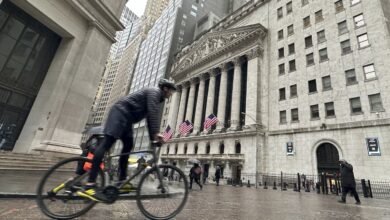Jerome Powell could spark a stock market surge—even without cutting rates, Wall Street guru says

Investors will be closely watching Federal Reserve Chairman Jerome Powell’s press conference after next week’s rate-setting meeting. Federal Open Market Committee (FOMC) officials are widely expected to hold interest rates steady on June 12, as inflation has stuck well above its 2% target and consumers are proving largely resilient to higher borrowing costs. But with just a few key words at his press conference next week, Powell could still give investors hope that rate cuts are on the way sometime this year, sparking a stock market rally. At least that’s the opinion of Ed Yardeni, the veteran Wall Street strategist and former Fed economist who now runs Yardeni Research.
Yardeni currently sees a 20% chance of a “melt-up” for the stock market, but if Powell “sings a dovish tune” at his press conference next week, he promises to raise those odds.
And it’s no wonder why, really. Powell has proven his ability to move markets with just a single phrase on numerous occasions, most famously at the Fed’s Jackson Hole symposium in August 2022. There, Powell warned that he was dedicated to fighting inflation, even if it meant there would be some “pain” for Americans. The comments led stocks to plummet in the following weeks as investors penciled in more aggressive interest rate hikes. Now, markets could be in for a different kind of surprise—and it’s one that would be far more appealing.
Still, in his Wednesday note to clients, Yardeni opined that there is no reason for the Fed to cut rates, given that the economy is slowing just as officials had hoped, enabling inflation to cool (slowly) without triggering a recession. The U.S. is experiencing the “soft landing” that Powell has been dreaming of since 2022 even with higher interest rates, according to Yardeni; not the “hard landing” that Wall Street wrongly predicted for years. That means interest rate cuts meant to stoke growth will do more harm than good—at least for the economy. Yardeni has warned for months that cutting rates at any time in the coming months would be a “mistake” that would only serve to reignite inflation.
Of course, for investors, Fed rate cuts are a different story. Lower borrowing costs and the promise of increased lending and investment in the economy are apt to supercharge the already impressive rally in stocks, which have clocked a nearly 13% rise year to date. Or as Yardeni put it: “If they do act prematurely [and cut rates]—before inflation is convincingly back down to their 2.0% target—they risk fueling a melt-up in the stock market, one that may already be underway.”
Still, most experts, including Yardeni, believe Powell will be careful not to sound too dovish in his post-FOMC press conference next week. “We expect Fed Chair Jerome Powell to push back against the markets’ excitement about the prospects of Fed easing,” he said.
Michael Gapen, chief U.S. economist at Bank of America, is also predicting Powell will “preach patience” at the press conference. In a Thursday note, Gapen said he sees the Fed revising its outlook to include slower economic growth that would typically call for rate cuts, but also “firmer” inflation that would call for rate hikes.
To his point, the Fed’s favorite inflation gauge hasn’t cooled as much as officials would have liked this year. Year-over-year inflation as measured by the core personal consumption expenditures (PCE) price index, which excludes more volatile food and energy prices, has fallen only slightly, from 2.9% last December to 2.8% in April. That would normally signal that interest rates need to remain high.
But at the same time, GDP growth slowed from 3.4% in the fourth quarter of last year to just 1.6% in the first quarter of this year, and that figure was revised down to a paltry 1.3% on May 30.
With these mixed messages coming from economic data, Gapen said, Powell is likely to signal that he will hold rates steady for “as long as is needed” to gain confidence that inflation is under control, but his fundamental disposition toward cuts won’t change, given the weaker economic growth.
“The bottom line is we think the message will be that the April employment and inflation reports, among other data, have reaffirmed the Fed’s view that the next move will be a cut. That said, it has not seen enough data to think that cut is coming soon,” he wrote.
Source link





